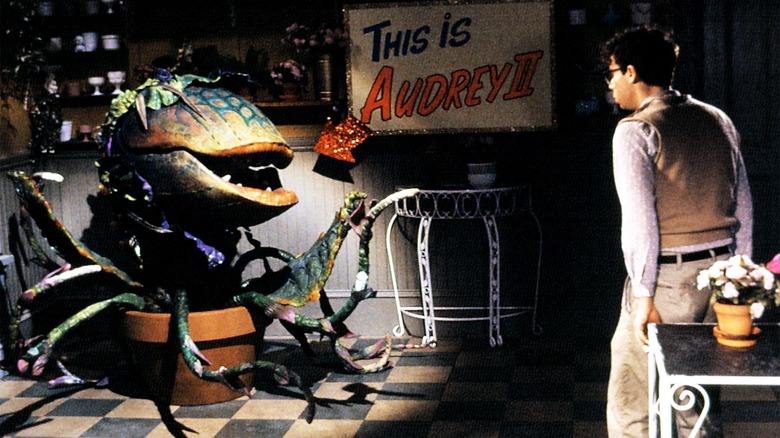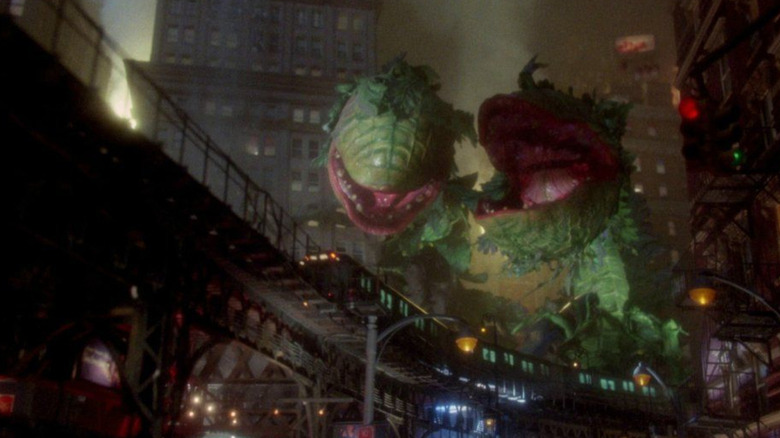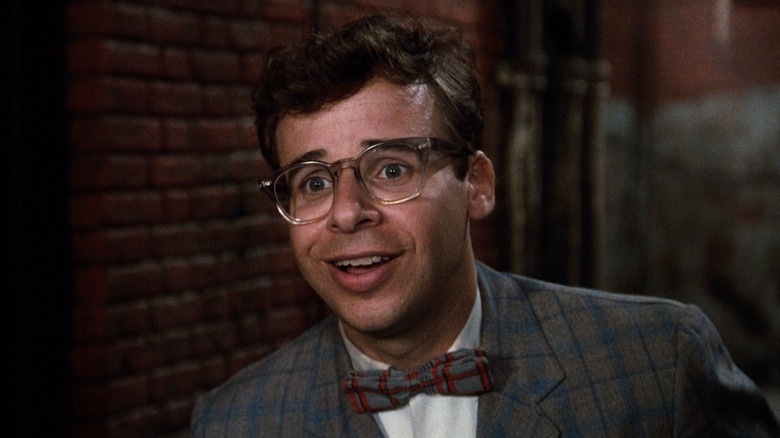Little Shop Of Horrors Originally Had A Much Darker Ending
Directed by B-movie legend Roger Corman, "Little Shop of Horrors" was a 1960 black comedy before turning into an off-Broadway musical with rock and roll, and Motown-style songs by Alan Menken and Howard Ashman. Ashman returned to write the screenplay for the 1986 film adaptation of the "Little Shop of Horrors" musical, helmed by the famed puppeteer and filmmaker Frank Oz. The cult classic follows a nebbish florist (Rick Moranis) named Seymour who discovers a chance to escape Skid Row when he meets a giant man-eating plant that grows larger the more it feasts on human blood and flesh. The plant, named Audrey II after Seymour's crush Audrey (Ellen Greene, reprising her stage role) who is in an abusive relationship with a sadistic dentist (Steve Martin), promises Seymour fortune and fame if he continues to find more prey.
The dreamy theatrical ending sees Audrey and Seymour live happily ever after in their "somewhere that's green." Seymour returns just in time to rescue Audrey from being eaten by Audrey II. He turns down an offer to sell other plants around the world and destroys Audrey II for the sake of mankind by electrocuting the monster plant. After they get married, Seymour whisks Audrey away to the comforts of suburbia. It's the kind of life the poverty-stricken characters always dreamed of, and the cutesy, bright colors illustrate their happiness. The only dark spot in this ending is the final shot of a tiny, smiling Audrey II budding in their flowerbed — a playful suggestion that Audrey II's reign might not be over yet.
The initial ending was more in line with the story's original iterations, but it was received poorly during test screenings. "Typically with test screenings, recommendation scores falling below 55% are cause for serious concern," The Dissolve explains. "Little Shop of Horrors" scored a dismal 13% on the first test screening and a 16% on the second. Franz Oz recalled to Entertainment Weekly:
"For every musical number, there was applause, they loved it, it was just fantastic ... until Rick and Ellen died, and then the theatre became a refrigerator, an ice box. It was awful and the cards were just awful."
The filmmakers were disheartened by the audience's reaction and forced by Warner Brothers to reshoot the ending. They scrapped the incredible model effects work by Richard Conway that cost $5 million and took over a year to create. In 2012, full-color reels of the bleak original finale were discovered and digitally remastered for the Director's Cut Blu-ray so that everyone could see the stark difference between the cheerful theatrical ending. What was it about the original final sequence that left audiences so cold?
An Audrey II apocalypse
The original ending portrays capitalistic greed gone apocalyptic. It's an audacious sequence with masterful puppet work and miniature effects by Richard Conway. The scene begins when Audrey is almost eaten by Audrey II and Seymour finds her wounded and nearly dying. They sing a somber rendition of "Somewhere That's Green" before Audrey asks him to feed her to the plant "So that it will live, and bring you all the wonderful things you deserve." After Audrey II slowly devours her, Seymour heads towards the roof to commit suicide and runs into a salesman proposing to put little Audrey II plants in every household across America. He returns to Audrey II, who sings a mean-spirited number "Mean Green Mother From Outer Space," and attacks Seymour — even with a gun! At the end of the song, Audrey II uses his vines to trap Seymour, laughing maniacally as he swallows him whole.
In the next shot, the girl-group Greek chorus stands in front of a giant American flag and solemnly sings of Audrey II's worldwide domination. A montage shows a feverish horde of people clamoring to get their own little Audrey II plants. Then, we see a giant Audrey II pummel its snake-like vines through the walls and bed of an elderly couple and its head burst through the wall of a nightclub. Outside, a massive plant swings on the Brooklyn Bridge as if it were a toy, and two others stomp through the streets of New York City, sending cars and rubble flying everywhere while the crowds scream and run in terror. Another mammoth Audrey II swallows a train that shoots straight into its mouth. Buildings explode. Glass shatters. Cars crash. Fires blaze. The fact that the plants cause all this destruction and death while laughing maniacally makes the scene extra chilling. While a helicopter circles them, a pair of Audrey II plants sit on top of the Statue of Liberty, their booming laughter echoing while the army ineffectually shoots them from below. Finally, Audrey II crashes through the movie screen itself, gaping, red mouth consuming the viewer — a nod to the stage show where the puppet and its branches extended into the audience.
It's a terrifying spectacle, especially when juxtaposed with the upbeat music and shot from the ground perspective of the terrified city-goers. Was this bombastic mayhem too much? "We tried to make it as humorous as possible," Conway said, "but it turned out to be quite realistic, and pretty heavy" (via Monster Legacy). There were several other reasons why audiences didn't respond well to this original ending.
Audiences loved Seymour and Audrey
In a New York Film Festival Q&A, Frank Oz felt the disapproval of the dark ending had to do with the difference in medium. He speculated that the cinematic close-up, as opposed to the static wide shot of the stage, made film audiences more sympathetic to Audrey and Seymour. Their deaths were easier to swallow (pun intended) in the stage version because they were quicker and you knew subconsciously knew they would appear again in the curtain call. In the film, Frank Oz uses point-of-view shots so that you see their helpless, terrified faces as they're led into Audrey II's cavernous and sharp mouth. This makes it easier to imagine the gruesome horror they will face once inside. Their demise is torturously slow and capped off with the sharp sounds of Audrey II greedily munching.
Another important factor was Rick Moranis and Ellen Greene's endearing performances and romantic chemistry. Audiences fell in love with them and wanted them to overcome Audrey II's wickedness, not succumb to it. Moranis portrays a sweet, innocent, and clumsy Seymour who kills his victims by mistake. In the stage play, Seymour is a bit more nefarious and easily swayed by the glitters of wealth and celebrity. The death of Audrey is seen as a deserved consequence of his actions.
Although "Little Shop of Horrors" is a stylized film with stage elements, audiences can easily suspend their disbelief with theatre productions. The stage show's ending is dark, but audiences can find comfort in its over-the-top silliness. In the film, the grim depictions of the lead characters meeting a grisly fate, followed by the destruction of the modern world as we know it, was too much for those test audiences to handle because of its realism. The special effects were almost too good, presenting an overwhelming and scary vision of humanity's final days. Whereas in the stage production, Audrey II's takeover is implied and largely left to the audience's imagination. The violence and destruction the intergalactic plant causes is never seen to such an overwhelming degree. Audiences were likely disturbed by seeing the harrowing scenario laid out on screen in such an elaborate way.
Which ending do you prefer? If you haven't seen it, you can watch the "Little Shop of Horrors" original ending on YouTube.


